
A Passion For Radio.
Part II.
Vintage Radios.
Notes on buying and refurbishing.
By Ian Walker. U.K.
Introduction.
My previous article [Part I] discussed some of my adventures while in the BBC, this time around I will write a few lines on old radios. To me most modern portable radios lack charm and if you look inside there might be a few integrated circuits and a smattering of discreet components and that's about it. In the heyday of Hacker and others there was a philosophy to make the best with no compromises. There were literally dozens of radio manufacturers especially in the valve days, less so by the early 1970's as cheaper far east imports came into the U.K. Often these were really small plastic radios for personal use and this tied in nicely with an increase in pop music and stations like Radio Luxemburg, these radios suited the 'on the move' teens of the time and very affordable, unlike Hacker who struggled towards the end of their existence as they never made sets like this as it would need compromises in circuits and materials and like many they went out of business in the late 1970's. Although I could write on many of the British manufacturers like Bush, Ekco et al I will stick to the samples I have, there's plenty of resources on many of the radio manufacturers can be found on the web.
Cautionary notes.
If you are new bto refurbishing older radios I would stick to battery transistor portables, being battery driven there is no chance of electric shock and unlike valve radios of yester year for the most part most of the components should still be in reasonable condition. A special case are old American valve radios imported into the U.K. At the time of manufacture they were originally designed to run off their 120v AC mains and ours being 240v AC so various means of reducing the voltage were used including using special resistive mains cable to drop the voltage. A safe method now is to use an externally cased 240v to 120v transformer if they have not already been safely modified inside the cabinet.
Approach.
There are several categories to approach old radios.
1. Buy fully working may be from a reputable vintage restorer on the Internet, these will cost a lot more but you will get a guarantee and it will be fully working up front and ready to go. This can be the best way to buy valve radios as a good restorer will have changed any defective components and brought it up to good cosmetic and safety standard regards wiring, earthing etc.
2. Buy a well described radio on eBay, possibly of later vintage of the 1960's-1970's like Hacker series [my Sovereign III falls into this category], look for a good condition one with all parts like knobs and switches all intact and needing modest restoration, there are plenty still around.
3. Buy a dirty tatty radio [my Dynatron Nomad falls into this category, see later picture before restoration] but described as working with all parts intact, it should be cheap, maybe just a few pounds but needs a fair bit of work on it.
4. Buy a radio that is described as faulty, this may be a simple or complex fault, it could be very cheap but in this last case you will probably need soldering and electronics experience and may need circuit diagrams and test equipment to complete a good job.

Comparison of size, Hacker Sovereign III, Dynatron Nomad and Roberts R66 4 valve radio
Hacker Radio.
The Hacker brothers started up their business in the late 1920's and for many years used the trade name of Dynatron, after money problems and take overs including Ekco for a while [E. K. Cole, another very successful radio and TV company based in Southend, Essex], the brothers decided to run a new company this time under their own name. The first transistor portable they made in 1960 was called the Hacker RP10 Herald MW LW radio and from there numerous models were introduced with Mk II's and III's on some models with later improvements in design and components when available.
Hacker Sovereign III.
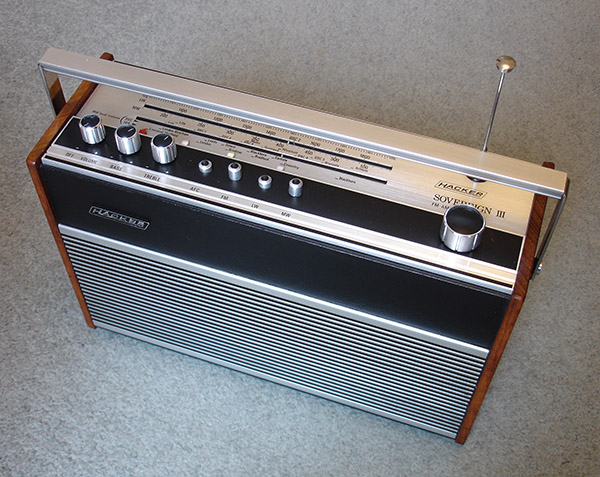
The beautiful Hacker RP72 Sovereign III LW MW VHF FM radio, introduced 1973. An even larger Super Sovereign with more features was also available. The list price in 1975 for the Sovereign III was £77.50 inc VAT, a lot of money for a portable radio!
Modern materials for the time including aluminium extrusions, alloy and steel handle, polished wood end cheeks and synthetic black leather make for a very stylish radio still well at home in a modern decor. This is the radio I use day in and out. Sensitivity and audio quality is excellent on all bands although some hiss is evident from the amplifier section on my sample compared to the Sovereign II.
The tone can be varied by separate bass and treble to fine tune the sound. LW sounds particularly good with deep bass on voices but good articulation, well suited to BBC Radio 4. Colour markers are useful for quick finding of stations. The 8x 1.2v rechargeable nicads I use give great life so if this was the full 12 volts with alkaline batteries it would be even better. Using a higher voltage from multiple batteries and then using an internal regulator as Hacker have done at a lower voltage is the key to reliable reception and low distortion over a long period. A later variant of this radio had an internal AC power supply as well as batteries. I have also owned a long time in the past the Hacker RP36 Helmsman MW LW & 3 SW bands, quite a complex radio, lack of selectivity and sensitivity using the telescopic aerial on the two higher SW bands made it only a fair performer overall.
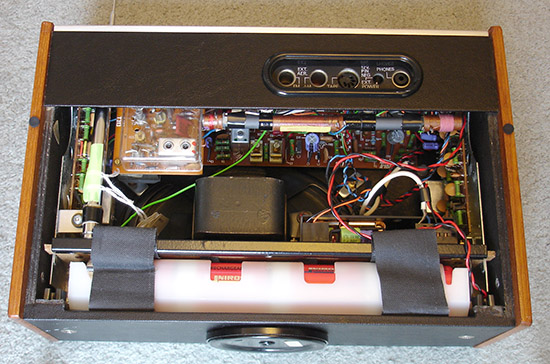
Internals of Sovereign III, Hacker used a modular approach to the boards on all their radios making servicing easier. A couple of screws on the base and the internal circuits built around an aluminium shell can be lifted from the substantial wood case making refurbishing on both easier, the battery compartment has pull out straps and the audio amplifier section just above the battery compartment is on a tray that can be slid out independently from the rest of the electronics. The speaker wires are clip on making it much more friendly than say the Roberts R66 soldered connections. Note the turntable on the base for getting best reception free from interference on MW LW.
Hacker RP25 Sovereign II.
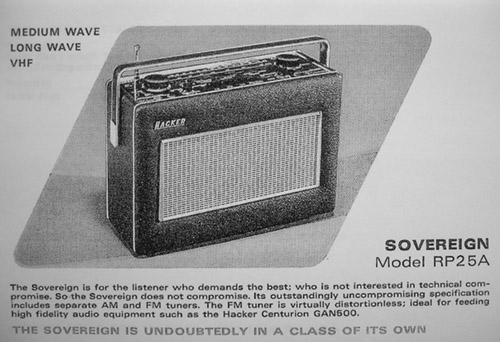
Before the Hacker RP72 Sovereign III came the Hacker RP25 Sovereign II, originally introduced as the Hacker RP18 Sovereign in 1964, it went through a few design and suffix changes. Quite a lot older in external design with padded black leatherette finish. I had one of these before the Sovereign III and it is a very fine radio but the older look in black and Perspex top looks much more dated now. In some ways though I think it had the edge on quality over the Sovereign III as it had a noticeably larger speaker, much longer ferrite rod for even more sensitive pick up on MW LW and very nice inter-station muting on VHF. This radio used double tuned IF transformers compared to ceramic resonators for the Mk. III together with 2 PP9 9v batteries rather than 8 D cells for the Sovereign III. Early Sovereigns use the Mullard germanium AF series of transistors which can be unreliable.
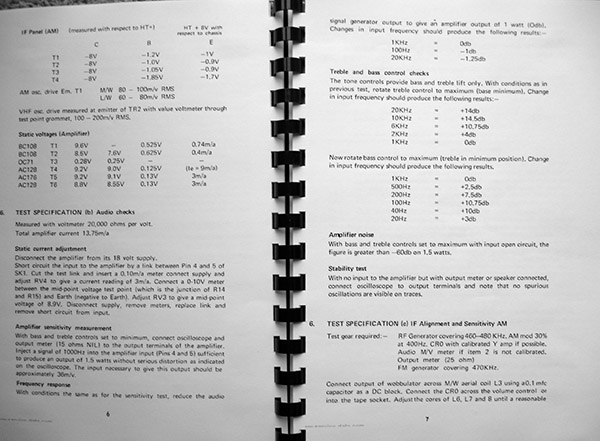
How many other portable radio manufacturers in their service book would quote the frequency response 100Hz-20KHz within tight limits for the audio section! These service instructions are still available on the web in pdf format, I have printed mine and ring bound them. Hacker's service books are a model of clarity.
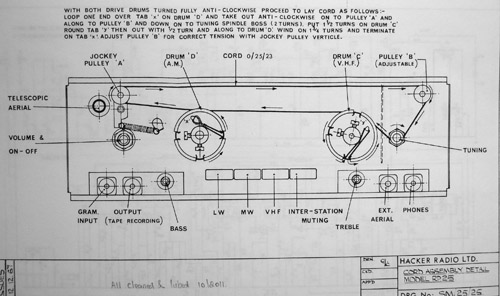
Showing the complex tuning method for the Mk II, this is what you see if you remove the Perspex tuning scale. The Mk. II used separate VHF and AM tuning capacitors, this was a combined unit in the Mk. III. Separating the circuits is expensive, indeed the whole radio is split into completely separate AM and FM sections, no compromises here.
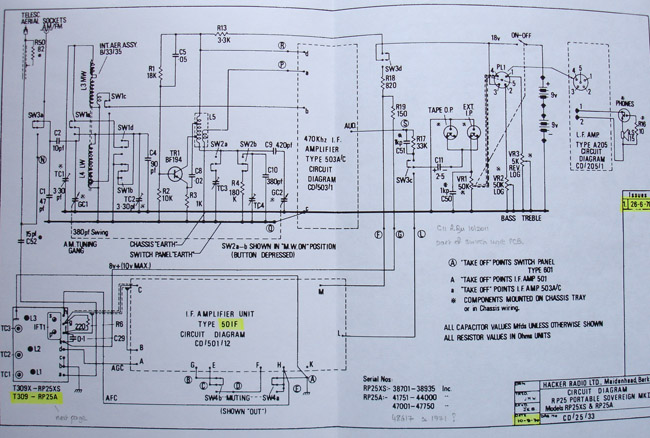
Block schematic of the Mk. II showing inter-wiring of boards and the different modules that make up the radio.
The whole policy of the Hacker brothers both under the Dynatron name and Hacker was to make top quality radios which were well designed and very well built, I don't think there was any U.K. company that bettered them at the time, I personally don't think Roberts who was a rival were in the same league as I have owned several radios from both companies.
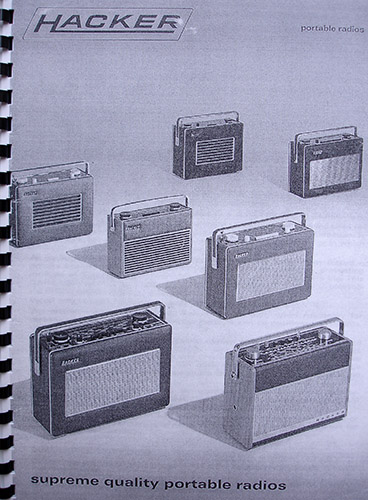
Typical brochure cover of Hacker radios.
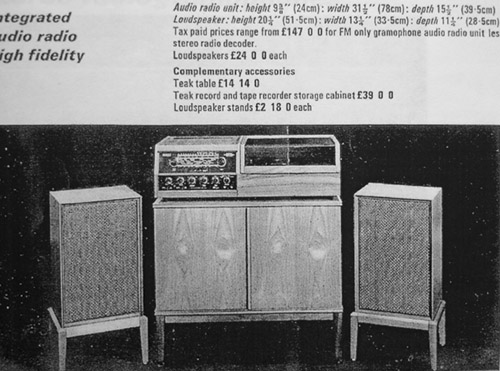
Dynatron and Hacker also made stereo hi-fi equipment.
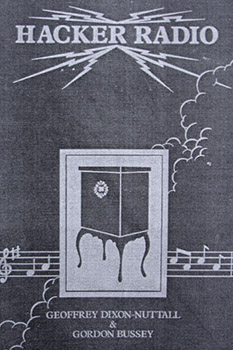
Hacker Radio booklet can be down loaded from the web and includes a nice history of the Hacker brothers.
Dynatron.
This trade name [combined from dyne and electron] was used for a long time by the Hacker brothers in the years of valve radio but also appears on some early transistor models like the Nomad, it was about this time in 1959 after separating from Ekco that the brothers left as directors from this liaison and started their own company Hacker. Early Dynatron high fidelity equipment and radios where all made to a high standard.
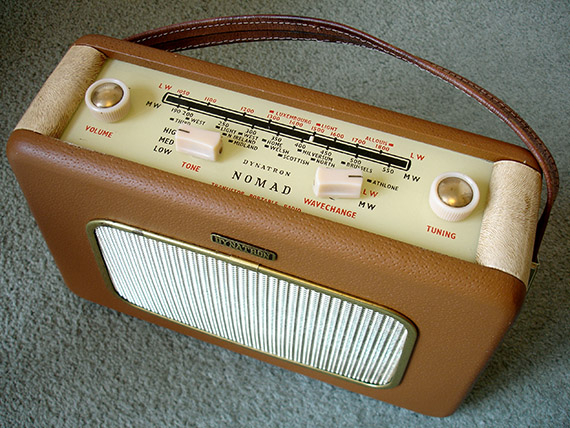
Dynatron Nomad c.a. 1959 after restoration, see later for its original condition.
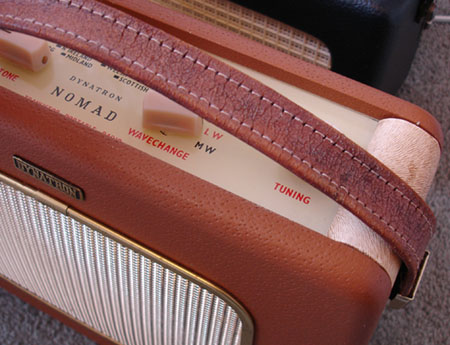
Detail of the new stitching on the handle, the old handle was falling apart as received.
[I can't take credit for the stitching as my brother kindly did it for me whilst I was working on the casing].
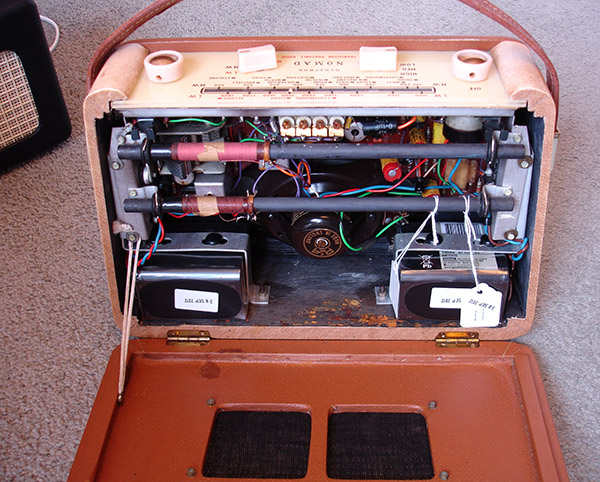
Internal picture of the Nomad MW LW radio, note the two long individual ferrite rods for MW LW, not sure why they did this except to keep wiring shorter as nearly all manufacturers placed the MW LW coils at either end of a single ferrite rod. This picture is after extensive refurbishment although all original components. The engrained 'rust like' deposits in the black stained wood base from leakage of old batteries is always a problem when previous owners don't remove them when dead, a good sized speaker is used and whilst audio quality is very listenable, the selectivity and sensitivity is not as good as the Sovereign III even after alignment. This radio used GEC transistors which are reliable. The new PP9 batteries were put in September 2012 and still going strong January 2013 as I write, a pair of these go for about £6 on eBay. Service sheets are available on the web.
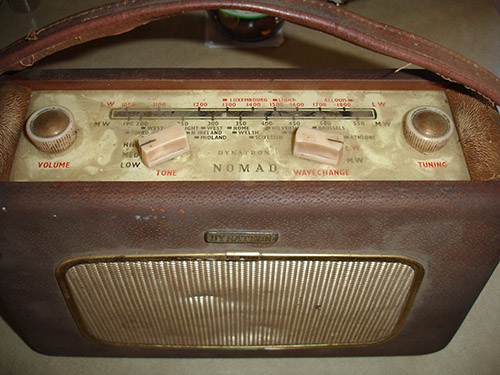
Original condition of the Nomad radio as received, bought for a few pounds on eBay.
Note the heavily dented metal speaker grill, this gave me a 'headache' repairing as the surrounding brass trim which is tightly fixed to the cabinet keeps the grill very solidly in place. Being unsightly in this condition I managed to ease it away from the case eventually after the radio chassis, speaker and speaker dust cloth were removed and used a small wooden hand roller that is used for wall paper edging and rollered the grill in several directions laying down on the kitchen lino'. Doing this ironed out the dents and brought back the natural curves to the grill, getting it back was awkward and required slight trimming of the edges of the grill.
Roberts.
A rival to Hacker and established back in early the 1930's, they made good radios but from my experience they were not as good as Hacker. Roberts still exist today in the U.K designing various models including the 'Revival' based on their 1960's radios but use imported DAB/FM electronics from the far east, their more expensive models have wood and leather covered cases made in the U.K. They have also diversified into a number of other radio related products. Their website gives full details. Although the Revival radios currently made suggest they work off batteries, the life span using batteries is poor, down to hours rather than the old radios where months of use on one set of batteries can be achieved if played at modest sound levels.
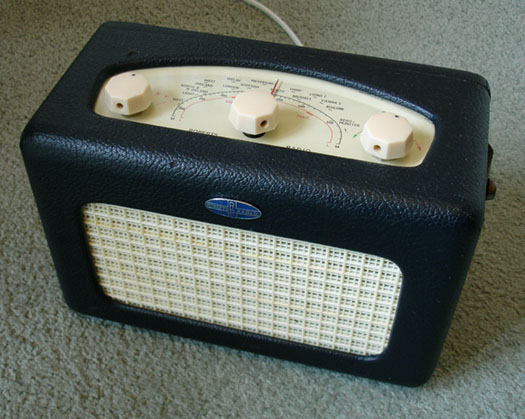
Small valve portables with miniature 7 pin valves like this one were introduced in the mid 1950's and had a very short life in the market place as within a year or two of large scale production of germanium transistors becoming available in the late 1950's they had virtually all disappeared by 1959. The first of the new 'all transistor' radios became widely available around 1957-1958 and some hybrids were made around this time using valves for the front end of the radio and a germanium transistors in the output stage, but again these had a short life on the market place.
This is a Roberts R66 c.a. 1956 valve portable with the leather handle pushed down behind to see the top panel, this is a small radio only 9 1/2" wide compared to the 12 1/2" of the Hacker Sovereign III but deep at 5", needed originally to accommodate the dry batteries for HT and LT. The audio quality and sensitivity are well down compared to the Hacker due to circuit design compromises like smaller speaker and only one I.F. stage making it rather insensitive, the sound is lightweight but crisp. If you think the valves need time to warm up it is not the case with the miniature valves used here as the sound is almost instantaneous due to quick heat filaments.
All good quality radios on MW LW use a system called AGC or automatic gain control so as you tune quickly between stations of differing signal strength the audio level is kept about the same preventing being 'blasted' on the speaker with strong local stations. On radios like the Hackers' this works very well but on this valve set the AGC is based on a valve design called vari-mu which unfortunately has hysterisis and not fast enough in operation so strong stations can sound much louder compared to weaker ones when tuning quickly.
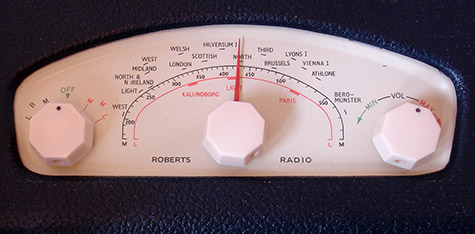
The retro knobs and tuning scale are rather nice and precise in operation.
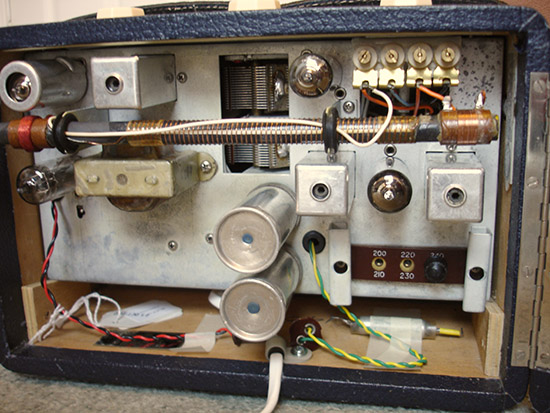
Internal picture of the 4 valve radio. This radio needed a fair bit of work both on the case and internals including replacing some capacitors that were alarmingly bulging. Originally the radio could work off mains or dry batteries, 90v HT battery for the anodes and another 1.5v LT battery for the filaments, these batteries are long gone and no longer available. A switch on the top panel selected mains or battery operation. The mains lead needed replacing and I added a strain relief to the cable. Annoyingly the lead is permanently connected to the radio rather than using a plug and socket arrangement which means a dangly cable every time you move it about.
Again with older valve radios caution must be used, this radio as manufactured used a simple half wave rectifier [in this case a small metal rectifier] to rectify the AC after the mains transformer for the valve anodes, these old metal rectifiers are rather unreliable and at some point in its history it had been replaced by a silicon diode but the problem is that metal rectifiers had a fairly high forward bias voltage drop so with a modern rectifier with much lower voltage drop the anode volts were all far too high when tested on a multimeter stressing the valves and components. I added a dropper resistor to the rectifier circuit to bring down to the correct voltage.
This shows the problem of repairs done without knowledge of original component specifications, new for old doesn't always work in these cases without further modification.
Although the internal layout of the major components on the upper side is quite neat seen here, the build on the underneath is poor with a messy layout of components and the metal of the speaker magnet and chassis comes rather too close for comfort to the HT circuits when assembled. A bigger cabinet would have given more breathing space and improved layout. One of the original electrolytic capacitors [correct polarity needed] had been soldered in the wrong way round!
General notes on restoration.
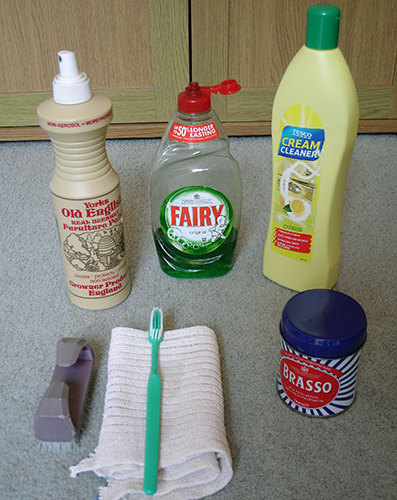
Simple cleaning solutions for old radio cases
Someone who restores radios a lot may have all sorts of potions and lotions for cleaning and restoring but as I only do this sporadically I use what I have to hand including those shown above.
I like to remove all the electronics and speaker from the case when working on restoring the outside finish. This is usually a matter of removing a few screws and releasing the chassis, on some radios the speaker wires will be soldered on making it more awkward. Also removing the back panel if screwed on with a hinge to work on an empty carcass allows easier cleaning, this is typical of Roberts radios.
If at all possible with the Rexine or leatherette I just use warm soapy water on a cloth with firm pressure but on heavily soiled cases the need of a cream cleaner can be useful. Various polishes can be used when the case has been cleaned to bring back a nice lustre or shine including standard furniture polishes, liquid beeswax used sparingly or car interior cream polishes. A small handbrush and old toothbrush can often be useful with Fairy Liquid or cream cleaner to get stubborn stains off. Although the Rexine or leatherette covers on the wood case are well stuck on caution is needed not to get too wet while cleaning as lifting can occur specially at the edges, it is fairly common to see some lifting of the edges due to the original adhesive drying out but with care these can be stuck back down.
On old radios with Perspex tuning dials it is often found the dial is covered in many tiny scratches from endless twiddling of the controls. After a good clean with soapy water to remove grit the upper surface can be buffed with a Duraglit wad until the scratches vanish, after the wad has been used I like to wash the residue off the Perspex with soapy water rather than dry cloth as this can add more scratches and then use a soft cloth for the final shine. Ideally the Perspex tuning dials should be completely removed from the case or electronics as this makes it much easier to work on.
Be careful with the Perspex panels [older Hackers for example] with all the stations printed on the underside when working on the upper surface as the paint can be fragile and even lift off if not careful. The Roberts radio shown here suffered badly from many fine scratches around the knobs, with a rather 'milky' opaqueness too but buffed up very well to an excellent clear shine and easily as this time the metal painted tuning scale is separate from the Perspex cover.
Regarding the electronics, a nice good quality unused long haired paint brush will remove dust and debris from the circuit boards and a vacuum cleaner with fine nozzle can remove dust build up from the internal surfaces like underneath the tuning scale or dials along with tweaking the brush about gently. It is not unusual to find long deceased spiders inside these cabinets.
Alignment & Fault finding.
The alignment and fault finding of the radio circuits is best left to those with the required knowledge, a good reason to buy a good working example. Early transistor radios used germanium transistors, those of the OC Mullard series like the OC44, OC71 etc [early Roberts transistor radios used these] are pretty reliable even to this day but the Mullard AF series used in the radio frequency and intermediate frequency stages of early Hackers for instance have rather a bad reputation for failing mainly by internal short circuits, modern equivalents of some of these AF series transistors are still available albeit in a different case package. Later radios of Hacker and other manufacturers swapped to silicon transistors for the most part and these are reliable.
Regarding very old valve radios, unless being restored by a competent restorer I would avoid them unless you have experience with these as many of the components will be well past their sell by date and some of the safety aspects of these old sets leave a lot to be desired.
Conclusions.
Although there are a good number of well designed and attractive modern radios, there is a certain charm regards older models from the 20th century. If well chosen one of these radios even though it may be well over 40-50 years old can still give very satisfying results. There is no reason not to buy an old valve radio, there were many really good makers but more caution must be used regards availability of parts and buying the set from a reputable source regards being properly tested for safety etc.
An early 1970's Hacker for those of us in Britain of which there are some very good examples still around is a safe choice along with some of the 1960's transistor radios from Bush, Roberts and Ever Ready for example are also well worth considering. As I am from the U.K. there is a bias from my point towards the U.K. manufacturers but in your own country there should be a good array of different models too. German models from Grundig, Blaupunkt and Graetz etc are also well regarded. In the U.S. a number of 'novelty radios' were in abundance between 1930's and 50's made in all sorts of guises from cigarette boxes to Disney characters and old phones which can be highly collectable but the electronics side of them in terms of design and safety could be questionable now unless well restored.
Modern reproductions.

Here is a novelty modern reproduction of the Bush TR30, here called the TR130, fetching shade of 'cow', it also comes in more traditional flavours. As a modern repro' it is small and light and I use it quite a lot and sits upstairs most of the time. It is surprisingly good being sensitive and although the speaker is small it has nice tone aided by the tone control. Bush also have made others of their range in modern copies including the very popular TR82 transistor radio introduced in the late 1950's.
Roberts also have reproductions of some of their 1960's models, the case work and leather finishes are very pleasing but battery life is poor on these sets mainly due to DAB which is power hungry. Roberts have a website and a lot of their models are available on Amazon.
Further reading:
Vintage Radios by Tony Thompson. An excellent book with a wealth of detail on refurbishing radios including safety and cabinet repairs on old valve sets. Many colour photographs.
Valve Radio & Audio Repair Handbook, Chas E. Miller, Newnes. A technical book with large Appendix of valve types and bases, black and white drawings and schematics throughout.
The Setmakers, A history of the radio and television industry. Keith Geddes & Gordon Bussey. A thick volume containing much information, pictures and adverts from bygone times of the Radio and TV industry. [2nd hand].
Radios. The Golden Age by Phlip Collins. Stunning colour photographs of American radios on top quality paper also includes some circuits, notes and adverts of the American scene of radios in the 1930-1950's. These in include many novelty radios of the time, a real good browse! [2nd hand].
Comments to the author Ian Walker welcomed.
Published in the January 2013 edition of Micscape.
Please report any Web problems or offer general comments to the Micscape Editor .
Micscape is the on-line monthly magazine of the Microscopy UK web site at Microscopy-UK
©
Onview.net Ltd, Microscopy-UK, and all contributors 1995
onwards. All rights reserved.
Main site is at
www.microscopy-uk.org.uk.